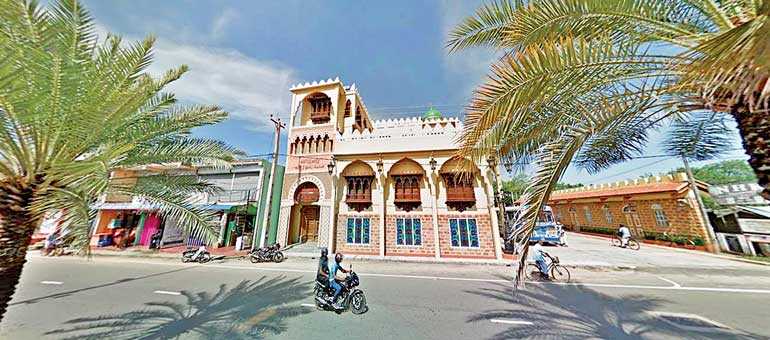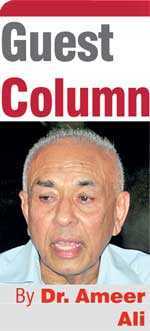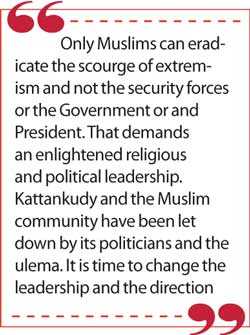Tuesday Mar 04, 2025
Tuesday Mar 04, 2025
Tuesday, 14 May 2019 00:10 - - {{hitsCtrl.values.hits}}

Surrounded by the Indian Ocean to the East, a lagoon to the West and two Tamil settlements, Arayampathi and Manchanthoduwai, to the South and North respectively, Kattankudy in Batticaloa district is almost 100% Muslim populated.
This township, with land area of just 6 km2, is crowded with around 50,000 people. Its population density will look more striking if one subtracts land occupied by public buildings such as the 60-odd mosques, about half a dozen schools, a hospital, main roads and byroads and so on. With increasing population and an expensive custom of gifting a house as part of dowry to each daughter, Kattankudy has no room to expand except grow skywards.
Two most outstanding characteristics
The two most outstanding characteristics of Muslims in this township is their pursuit of business activities and commitment to the religion of Islam. A vast majority of Kattankudy men were, until recently, farmers, pedlars, petty traders and retail businessmen, whose shops and boutiques spread out all over the country.
The popular saying that there is no place (in Sri Lanka) without a crow or a man from Kattankudy, amplifies those men’s business ubiquity. Because of their preoccupation with trade and commerce, modern education remained their least preferred pursuit for a long time. The majority of the boys dropped out of school after grade five or six and went into business, whereas girls dropped out even before grade five. 
Even though the colonial government opened its first Central College for Muslims in 1930 at Kattankudy, it was only in 1960 that one student from that township was able to enter the University of Ceylon, and that too not from that Central College but from Colombo Zahira College.
Today, the situation is different. Because of dwindling business opportunities due mainly to rise of an aggressive commercial class, particularly among majority Sinhalese, and to a lesser extent among minority Tamils, the Muslim community in general, which historically earned the sobriquet “business community,” had been forced to look for other avenues to survive economically.
Education became a sought-after alternative, especially after the LTTE and other Tamil groups began harassing Muslim businessmen and encroaching into their paddy lands. Facilitated by a number of changes in the National Education Policy after 1970, which made access to higher education more equitable, and aided by a Muslim Minister of Education, who wanted his community to take advantage of the changes, parents of Kattankudy began to show interest in their children’s education. As a result Kattankudy has produced a number of professionals such as doctors, lawyers, dentists, and teachers, both among men and women.
Still, the lure of business has not disappeared. Kattankudy businessmen, who prior to the 1980s had their shops and boutiques established in many Sinhalese and Tamil towns, slowly started closing them because of stiff competition and drifted towards their home town. As a result, the main street of Kattankudy is one of the largest and bustling bazaars in the country today.
Piety and profit motive prosper together
Kattankudy is a Muslim enclave where piety and profit motive prosper together and feed each other. In 2009, I published an article titled ‘Kattankudy in Eastern Sri Lanka: A Mullah-Merchant Urban Complex Caught between Islamist Factionalism and Ethno-Nationalism’ (Journal of Muslim Minority Affairs, vol. 29, no. 2, June 2009). The following quotes are directly from that article with minor changes:
“After the 1970s however, the religious fervour of this place received a fresh fillip with … migration of Muslim workers to the Middle East, especially to Saudi Arabia. The Saudi-returnees brought … with them a strand of Wahhabi thought and practices … They reject Sufism and all rituals and teachings associated with it. They simply categorise Sufism as bid’a or innovation … crept into Islam and marred its purity… In Kattankudy also … Middle Eastern hijab and thobe increasingly becoming part of the female and male attire respectively, and … replacing the traditional sari-veil and sarong, with frequent fatwas from a new crop of inexperienced and young imams condemning music, films and other means of aesthetic and social enjoyment, and with an increasing …(mix) … of Arabic terminology in the spoken Tamil dialect of the elite there are clear indications that … local culture is undergoing a transformation towards Arabisation.”
“Moulvi Abdul Rauf, a native of Kattankudy and … son of a prominent alim, and M. S. Abdul Paylvan, President of All Island Tharikathul Mufliheen of Maruthamunai … were two preachers who believe in the religious legitimacy of Sufism and many of its practices. Rauf has a long history of religious controversy in Kattankudy, but Paylvan’s influence came much later and particularly during and after 1990s. In fact Sufi ideas and … influence of Sufi sects or tarikas had been prevalent among the people … long before Rauf or Paylvan came into the scene. At that time there was no open and violent ostracism of such ideas and their advocates, although there were occasional outbursts against them in the sermons of mainstream ulema.” The ideology and practices of Rauf and Pylvan were rejected not only by the Saudi educated graduates but also the rest of the ulema. However, “the violence that occurred in 2006 after the death of Pylvan, which ended in … destruction of … houses and property, and the fatwa of apostasy against them was something new and mark the culmination of a puritanical trend that was growing since late 1970s. While the Wahhabi driven Islamism is on the rise in Kattankudy, religious factionalism has also crept into politics of the area and is ripping apart the internal peace and tranquillity of the locality.”
These were quoted not to claim that “I said so”, but to demonstrate how Kattankudy was transforming from religious conservatism to religious extremism quite unobtrusively.
Since that article was published, Kattankudy has transformed into a mini Arab town with date palms decorating its main street and Arabic written signs decorating arches and shop entrances. There was also an attempt to change the name of this town to Qahatankudy, claiming, without historical evidence, that the early settlers in this town came from a place in Yemen called Qahatan. Later it was claimed that this was an attempt to attract petrodollars from a rich Saudi family, Qahtan.
Religious conservatism
Even before Wahhabism intruded and Arabised the hearts and minds of its people and the environment, Kattankudy was known for its religious conservatism. However, it was a conservatism of a syncretic Islam mixed with rituals, ceremonies and practices derived partly from Hindu traditions which, in a sociological sense, played a positive role in bringing people together and maintaining social relations. A few examples will illustrate this point.
During the third month of the Islamic calendar, mosques in this town celebrated the birth of the Prophet over 12 nights, by reciting mawlood (panegyric poetry) after the evening prayer, and which ended in distribution of free food, mostly rice cooked with ghee, to all participants. More than a religious ritual it was a social occasion where people, young and old, gathered and dispersed with happy feelings.
Similarly, during the eighth Islamic month there was Bukhari recital, which involved reading the multi-volumes of Imam Bukhari’s Hadith collection, by the ulema in the two big mosques. That also used to end in food distribution.
These were also occasions in which people fulfil their vows taken previously and donate food or oil or even chooks and goats to the mosques, part of which were auctioned and money went to the mosque fund. This was also a Hindu tradition crept from India into local Islam.
There is a shrine in this town called Mawlana Kaburady, which people used to visit and donate money on the eve of a wedding or circumcision. Finally, during the two Eid festivals the main street of Kattankudy would be turned into a carnival site with food and game stalls, music and entertainment.
Spread of Wahhabism
After the 1980s with the spread of Wahhabism all this disappeared and occasions of communal gathering and socialising in public were lost. (Two years ago I visited the shrine at Mawlana Kaburady. It is now a small enclosed compound of about 10 square yards visited rarely by any and cared for by one of the descendants of that Mawlana family). In the name of pure Islam festivals lost their festivities and religious ceremonies lost their sociological significance. Even modern education could not change the puritanical mindset nurtured by the conservative ulema.
Before Wahhabi intrusion and since 1960s, Kattankudy had an island-wide reputation for Tabligh Jamaat (TJ) missionary work. Teachers, students, doctors, engineers and businessmen left for three days, three weeks or even three months at a time on Jamaat work sacrificing their studies, families and work. These missionaries were very peaceful foot soldiers of Islam and never preached violence or advocated Islamic state. Mosques were their abode when they were not at home or work.
They were a type of mystics or quietists. They never openly criticised any variants in the way Islam was practiced by others. Their outlook was to seek success in the Hereafter by faithfully observing the ‘five pillars’ of Islam.
On the contrary, to the Wahhabi ideologists piety must be pure and purity meant eradication of all accretions into the original Islam of the Prophet and his immediate disciples, Salafs. Shiism, Sufism, shrine worship and every other bid’a or innovation were condemned. It was this aggressive preaching and readiness to condemn the deviants as apostates that brought religious violence into Kattankudy in the 1990s. From the quietist Tablighis, Kattankudy was gradually falling into the hands of Wahhabi extremists.
National Tawhid Jamaat
Even then, Kattankudy did not grow into a hotbed for religious violence until the birth of the National Tawhid Jamaat (NTJ), which broke off from its parent Sri Lankan Tawhid Jamaat (SLTJ) sometime around 2015.
However, between c. 2000 and 2015 something else was changing the mindset of a younger generation of Muslims. This change was not confined to Kattankudy alone but in greater part of the Muslim world. The young men and women of this generation, who were in their late teens or twenties, like their counterparts elsewhere, were proud owners of a new set of electronic toys and gadgets such as laptop, and hand phone, which gave them instant access to news and views about happenings in the Muslim world.
For example, pictures of US bombings in Afghanistan and Iraq, Israeli bombings in Gaza, India’s atrocities in Kashmir, NATO’s so-called humanitarian intervention in Libya, the killings in Syria and Yemen and several other bloody scenes were now being relayed directly into Muslim bedrooms and lounges all over the world including Kattankudy.
These were portrayed by the Al-Qaeda, the Taliban, Boko Haram, ISIS and several other radical groups as the Crusaders’ war against the Muslim umma. Some Muslim youth obviously were attracted to this preaching of hatred.
Ummat al-Islam
Ummat al-Islam is a unique concept binding all Muslims into a community, and it is more universal and inclusive than Ibn Khaldun’s Arabic concept of asabiya or espirit de corps, which is exclusive and more ethnic or tribal.
The term umma occurs at least 62 times in the Quran, and in one instance it occurs as ummatan wahidhatan, meaning one single community, and in another as ummatan wasatan, meaning a middle community avoiding extremism. The Prophet emphasised this oneness in his last sermon at Arafat.
Umma binds every Muslim and that binding makes a Muslim feel for the sufferings of fellow Muslims, irrespective of their nationality or ethnicity. It is this feeling that is strengthened through modern information technology and its network society.
Educated and reasonably affluent Muslim men and women with access to this technology and relying almost solely on information received through the social and electronic media are easily swayed by radical preachers and their (mis)interpretations of the Quran and Hadith. Those young men and women who migrated from various parts of the world to join ISIS were members of this network society.
It is no surprise that in Kattankudy also, members of NTJ, under its firebrand preacher Zahran Hashim, fell prey to radical messages from abroad. However, Zahran’s link to ISIS is yet to be proved.
Kattankudy has its own Jamiyyathul Ulema, the apex religious body. It is a branch of the All Ceylon Jamiyyathul Ulema. Both bodies are now condemning NTJ and its jihadism. Were they totally ignorant of the activities of this group?
In a crowded enclave like Kattankudy it is impossible to hide secrets. What we gather from Kattankudy sources is that Zahran was attacking the mainstream ulema rather than advocating Jihadism. Is this why JU and ACJU are condemning him now? There are too many questions yet to be answered.
In this context there is a crucial issue which the ulema has to confront and resolve. It is an issue common to all minority Muslim communities living in non-Muslim plural societies. How do the ulema or ACJU in Sri Lanka reconcile the universally inclusive concept of umma, which binds all Muslims, with the nationally-restrictive Prophet’s saying, hubbul watan minal iman, meaning, a part of the faith is love of one’s homeland, and binds them to the country in which they live?
Some say that this saying is a fabricated one. Whether it is fabricate or not, the issue must be faced. To a minority Muslim community, which one of the two should take precedence? Should Muslims living in a non-Muslim country be encouraged to join an external group like ISIS and fight for a caliphate in the name of ummat al-Islam or be encouraged to defend their own country against ISIS and such other foreign elements and defend one’s homeland?
Time for change
There is an inherent clash between umma and watan. The answer to this clash lies in the Quranic advocacy of ummatan wasatan, and that should be taught to children in schools and explained in sermons in the mosques.
NTJ was caught between the two, because mainstream teachers and preachers of Islam neglected this lesson. It is in the skilful navigation between the clashing waters of umma and watan that the long run survival of the Muslim community lies.
I agree with Professor Kumar David that only Muslims can eradicate the scourge of extremism and not the security forces or the Government or and President. That demands an enlightened religious and political leadership. Kattankudy and the Muslim community have been let down by its politicians and the ulema. It is time to change the leadership and the direction.
(The writer is attached to the School of Business and Governance, Murdoch University, Western Australia.)
Discover Kapruka, the leading online shopping platform in Sri Lanka, where you can conveniently send Gifts and Flowers to your loved ones for any event including Valentine ’s Day. Explore a wide range of popular Shopping Categories on Kapruka, including Toys, Groceries, Electronics, Birthday Cakes, Fruits, Chocolates, Flower Bouquets, Clothing, Watches, Lingerie, Gift Sets and Jewellery. Also if you’re interested in selling with Kapruka, Partner Central by Kapruka is the best solution to start with. Moreover, through Kapruka Global Shop, you can also enjoy the convenience of purchasing products from renowned platforms like Amazon and eBay and have them delivered to Sri Lanka.
Discover Kapruka, the leading online shopping platform in Sri Lanka, where you can conveniently send Gifts and Flowers to your loved ones for any event including Valentine ’s Day. Explore a wide range of popular Shopping Categories on Kapruka, including Toys, Groceries, Electronics, Birthday Cakes, Fruits, Chocolates, Flower Bouquets, Clothing, Watches, Lingerie, Gift Sets and Jewellery. Also if you’re interested in selling with Kapruka, Partner Central by Kapruka is the best solution to start with. Moreover, through Kapruka Global Shop, you can also enjoy the convenience of purchasing products from renowned platforms like Amazon and eBay and have them delivered to Sri Lanka.